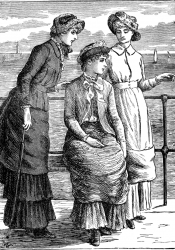Exhibition of the Rational Dress Society
The exhibition put on by the Rational Dress Society in 1883 captures the innovative spirit of the Society itself. Established in 1881, the society would put together their exhibition two years later in Prince's Hall, a public event space located on Piccadilly Street in London. This event would be the culmination of the Society's main goal: to promote and encourage dress reform among men and women, who would meet in separate groups to organize lectures, publications, and other public projects. The Society defined rational dress according to the following five qualifications: freedom of movement, absence of pressure over any part of the body, not more weight than is necessary for warmth, and both weight and warmth equally distributed, grace and beauty combined with comfort and convenience, and not departing too conspicuously from the ordinary dress of the time. A further goal of the 1883 Exhibition was to create both a supply and demand for rational dress by introducing the public and clothing trades to qualifying articles, and informing the public where such garments could be obtained. Ultimately the ideas of the Rational Dress Society did have an impact on the way clothing for both men and women was viewed. Despite this impact, it would be the natural change in fashion trends from 1900-1920 that would allow for clothing that more closely mirrored the requirements of rational dress, ending with the boyish and loosely flowing silhouettes of shorter 1920's dresses. This time period mirrored that of Woman's Suffrage campaign that ended with women obtaining the vote in 1918.
Though it is rare to find publications from the Society that are within easy access, Google Books offers a free digitized version of the pamphlet from the event entitled The Exhibition of the Rational Dress Association Catalogue of Exhibits and List of Exhibitors. This primary source offers fashion plates depicting rational dress costumes shown at the exhibit, and detailed explanations of how the judges determined the winners of each category. In 2000 Ohio State University put together an exhibit of dress reform during the Victorian period that covers rational dress and beyond. This exhibit was created from Ohio State's Historic Costume and Textiles Collection, and is entitled Reforming Fashion, 1850-1900: Politics, Health, and Art. One of the best places to find opinions of and reactions to the ideas of the society were the newspapers and editorials published, such as this early article from the year the Rational Dress Society formed from

